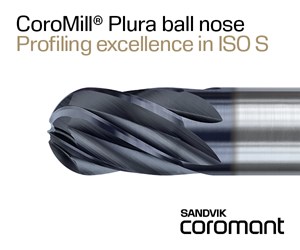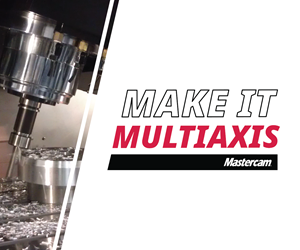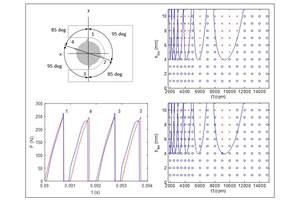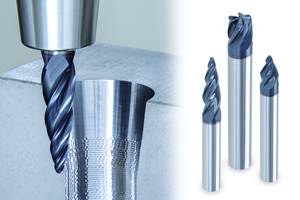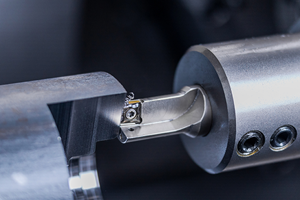High-Productivity End Mills Made Possible Due to Tech of Penn Plant
Seco Tools cites the Stabilizer 2.0 end mill as an example of the type of product it is able to manufacture because of the grinding technology that has been part of the improvement of its Niagara Cutter facility.
What does it take to employ the full cutting capabilities of today’s machining centers? According to Senior R&D Engineer Dennis Noland of Niagara Cutter, one important factor is the modern programming software of today’s CNC tool grinding machines. These advanced programming capabilities recently allowed Niagara to realize design features on its “Stabilizer” end mill that had previously been imagined, yet were impractical for the company to achieve in years past. Starting last year, however, the company began leveraging the most up-to-date programming capabilities of its Rollomatic and Walter grinders to manufacture a revised and more capable version of this heavy-roughing end mill, the Stabilizer 2.0. Mr. Noland says the new tool routinely achieves two times the metal removal rate possible with its predecessor—to the point that even on powerful 50-taper machines, the tool can make use of all the machine’s power in heavy roughing cuts.
Niagara Cutter is a Seco Tools company, acquired in 2010. Mr. Noland was part of a press event at the Niagara facility in Reynoldsville, Pennsylvania, that aimed to show the results of the parent company’s ongoing investment in this location. With more than 110 people on staff and 70 CNC tool grinders, the Niagara site has become a major manufacturing plant for Seco, capable of producing not just Niagara-brand products but any other Seco product as well, such as the Jabro Tools end mill line. Indeed, Seco's solid carbide FeedMax drill line is made here currently, and Seco North America President Rob Keenan says investment into the Niagara plant will continue at the level of $25 million over the next three years.
The Stabilizer end mill family is a signature product for Niagara. This tool uses variable geometry (engineered to be deliberately different from flute to flute) to ensure stable cutting at heavy depths by preventing harmonic cycles during cutting that might feed resonant vibration. Through flute-to-flute variations in helix, rake and relief, the tool enables deep, full-slotting milling passes in even hard metals without the chatter that might otherwise occur because of a conventional tool’s highly regular cutting edge impacts.
Significantly, though, what the established Stabilizer design lacked was fully asymmetrical geometry on every cutting edge. A four-flute Stabilizer featured a fixed set of geometries for rake, relief and helix for each flute, creating an imbalance at the back of the flutes. Previously, a tool with fully asymmetrical geometry was impossible for the company to mass produce economically. Now, through new grinding machine programming capabilities combined with custom-engineered grinding wheels, Niagara has introduced the new version of the tool in which every flute is fully asymmetrical within itself, allowing stability throughout the entire cutting length. With this enhancement, the chatter-free metal removal rate that the tool can achieve has been extended that much further.
Other factors also contribute to the advance, Mr. Noland notes. The new tool also leverages the improved transverse rupture strength of today’s carbide. When this new tool cuts at its full sustainable force, he says, the tool deflects by 0.020 inch. Carbide of the past would not have permitted this.
The Stabilizer 2.0 is an example of Niagara Cutter’s aim to fulfill what it sees as the role of the milling tool: enabling maximum use of a machine’s potential capability. For lower-power machining centers, Niagara offers its “Multi-Flute” tools in combination with a technique it calls optimized roughing. Combining high axial depth of cut with trochoidal milling, the technique employs end mills with a high number of cutting edges (typically six or more flutes) to peel away material at a high linear feed rate combined with low, steady radial engagement that keeps cutting force and heat buildup consistently low. That cutting looks like this:
The next level, Mr. Noland says, will be to combine these different approaches to productive cutting. The company is experimenting with Stabilizer 2.0 tooling in processes featuring optimized-roughing-style tool paths. Whereas the company’s Multi-Flute tooling is capable of about 10 percent radial engagement in a typical optimized roughing process for lighter-duty machines, the tool with the features impeding resonant vibration has proven capable of 75 percent radial engagement within comparable cuts on heavy-duty machines. Niagara Cutter and Seco Tools thus hope the milling of the future might increasingly look like this:
Related Content
New Modular Tool Options for Small Spindle Milling
Tooling options have been limited for small spindle milling applications. Now modular, indexable systems are available that provide broad flexibility to get the right cutter for the job with less inventory and at lower cost.
Read MoreThe Impact of Cutting Teeth Spacing on Machining Stability
Many cutter designs are available, and variable teeth spacing (or variable pitch) cutters can be used to influence milling stability. Let’s discuss why teeth spacing affects stability.
Read MoreTungaloy Expands Line of Barrel-Shaped End Mills
The new SolidMeister barrel end mills are efficient tools for complex 3D-surfacing operations used in mold making, orthopedic implants and the machining of other freeform surfaces.
Read MoreCeratizit's Updated Tooling Solutions Improve Machining Performance
The company has upgraded its EcoCut indexable inserts lineup, as well as introduced two new toolholding and workholding solutions.
Read MoreRead Next
3 Mistakes That Cause CNC Programs to Fail
Despite enhancements to manufacturing technology, there are still issues today that can cause programs to fail. These failures can cause lost time, scrapped parts, damaged machines and even injured operators.
Read MoreThe Cut Scene: The Finer Details of Large-Format Machining
Small details and features can have an outsized impact on large parts, such as Barbco’s collapsible utility drill head.
Read More
.jpg;width=70;height=70;mode=crop)






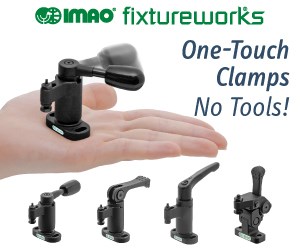

.png;maxWidth=300;quality=90)
